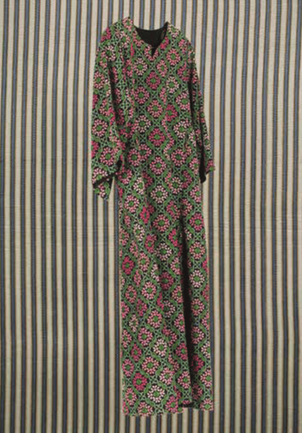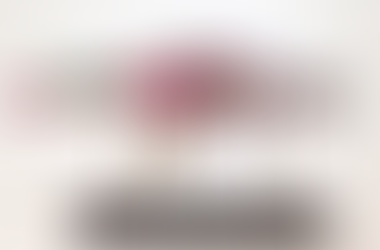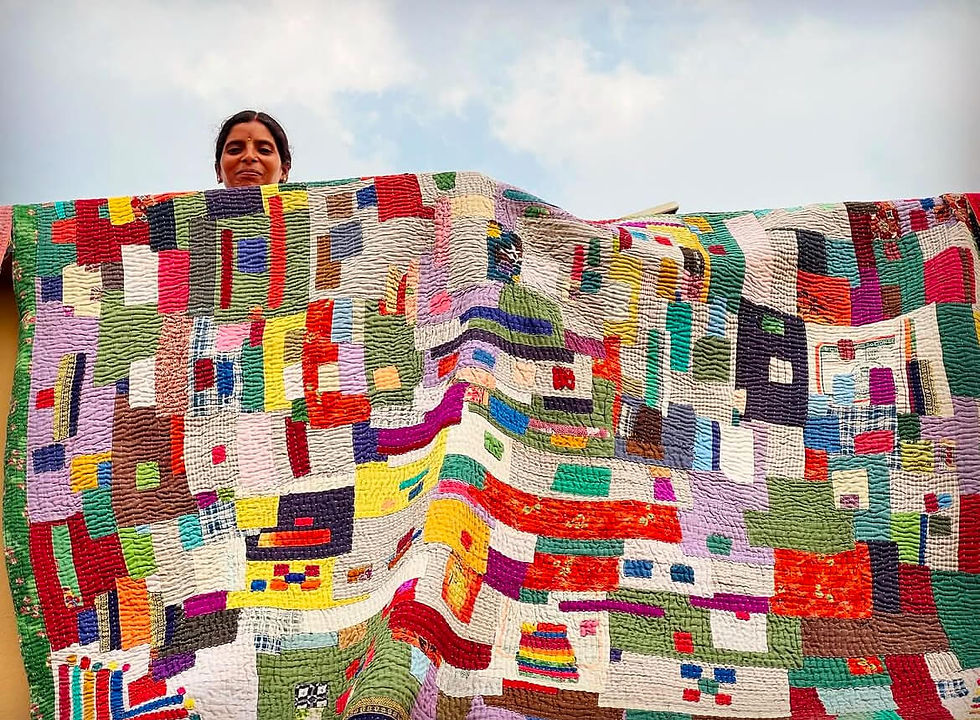Artists for Equality - Palestine
- DEA
- Jun 29, 2020
- 5 min read
Updated: Jan 28, 2021
Written by Aditi Patwari
The Palestinian-Israeli conflict has been ongoing for over a century. As this is a complex subject with a long history, we are not including our own point of view, rather uplifting the voices from communities that are being affected by the current situation.
Palestine has a rich history of textiles, where every region has its own unique embroidery technique and visual language. Let us learn more about how contemporary artists of the Palestinian diaspora are using this history to keep their culture and heritage alive.
Raja Al-Zeer
Medium - Hand Embroidery
Embroidered dress by Raja Al-Zeer, 2008, courtesy of Raja Al-Zeer (Left) , Detail of a dress from Bir Al-Saba, 1940s, from the collection of Birzeit University Museum (Right)
Images by Kayane Antreassian for the Palestinian Museum
Via Labour of Love
Raja Al Zeer is a Palestinian Embroidery artist who has been practicing for over 50 years. In 2012, both her arms were broken by Israeli settlers when she was out in the wild with her husband and friends. When one of her hands healed again in 2018, she started embroidering again, making dresses, home decoration and frames. Her main body of work consists of thobes, the traditional Palestinian dress.
Raja's embroidered thobe was part of the 2018 exhibition Labour of Love at Palestinian Museum. In an interview with Middle East Monitor, she talked about her exhibited work:
"That thobe was a masterpiece, I wore it at my son’s wedding ten years ago… the cloth was fully embroidered and it took me about one and half years of work. The Palestinian Museum invited me to hold two training workshops to teach embroidery, which I did… we need to introduce it to the younger generation and make sure they know about our heritage. It’s our identity, it’s the Palestinian culture, we have to defend it. Israel tries to claim our culture, they learn about it and then say it’s theirs."
Medium - Hand Embroidery
Silence Is Sold By The Pound (Top Left), The Arab Apocalypse (Top Right), and the sea drowning
the sea (Bottom Left), Study (Extinguished sun) (Bottom Right)
Image courtesy - Jordan Nassar
Jordan Nassar’s favored subject is landscape. He embroiders his compositions which are framed by repeating patterns adapted from traditional Palestinian motifs. The artist is of Palestinian descent, but was born and raised in New York City. Extending from this, his work evokes a very particular kind of imagined space: the sort of utopian vision of Palestine held by the displaced constituents that comprise the region’s diaspora.
Each recent work begins with Nassar creating a composition out of his patterns, sections of which he designates for the landscapes. He then sends this work to women in the Hebron region of Palestine who embroider the patterns in colors of their choice, sending them back to Nassar, who responds to their choices in his renderings of the landscapes. As such, two cultures coincide in Nassar’s canvases. The longstanding familial, matrilineal transmission of the embroidery tradition in Palestine with the Western, painterly impulses of Nassar’s upbringing and context as a diaspora Palestinian living in New York.
In conversation with Jordan this month, The National wrote:
"Nassar’s art practice also encourages engagement between [Israel and Palestine]. Unlike other Palestinian artists who refuse to collaborate with Israeli institutions, Nassar has shown at the Centre for Contemporary Art in Tel Aviv, and regularly visits friends in Israel. He is defensive about this decision, explaining that the stance of the BDS movement, which calls for boycotting, divestment and sanctions against Israel, often does not correlate with the realities on the ground. Palestinians and Israelis exist in the same economic sphere and – out of necessity or tolerance – work together."
Medium: Prints & Fashion
Prints of Palestine Collection by Natalie Tahhan
Image courtesy - Natalie Tahhan
Natalie Tahhan is a Fashion Designer based in Jerusalem. A graduate of London College of Fashion with a Bachelor of Arts (Hons) degree in Fashion Design & Technology, Natalie has worked extensively across Europe and the Middle East within the field of art and design. Tahhan has decided to carry her talents back home in hope of creating a platform for her creativity.
Her collection ‘Prints of Palestine’ celebrates the language of Palestinian embroidery, consisting of intricate and culturally rich elements inspired by traditional Palestinian embroidery motifs from five different regions. Highlighting historical motifs of Jerusalem, Hebron, Gaza, Jaffa and Ramallah, the collection redefines Palestinian embroidery into conceptual, vibrant, contemporary fashion prints. Every unique print communicates a different language, colour and identity, specific to each region. Made in Jerusalem, the collection preserves Palestinian heritage and reimagines the traditional styles of the past, bringing Palestinian embroidery into the 21st century.
The designer talks about the significance of Palestinian Embroidery and design; as dresses worn by women could reflect their personality, where they were from, etc. In an interview with Al Arabiya, Natalie said:
"When I started working on the project, what I wanted to highlight was that Palestinian embroidery was actually a language in the late 18th or early 19th century...People look at these motifs aesthetically and don’t really know that they have a meaning. I wanted to bring that back. I felt people could relate to the pieces in that way."
Laila Shawa
Medium: Mixed Media
(Clock-wise from top left) The Impossible Dream, Fashionista Terrorista, Shujayya, Disposable Body, Where the Souls Dwell
Born in Gaza in 1940, Laila Shawa graduated summa cum laude in Fine Arts from the Italian Accademia di Belle Arti in 1964 and received a diploma in plastic arts from the Accademia San Giacomo in Rome. From 1965 to 1967, she returned to Gaza to teach arts and crafts to underprivileged children. She now lives and works in London. As a Palestinian artist, Shawa’s concern is to reflect the political realities of her country, becoming, in the process, a chronicler of events. Her work is based on a heightened sense of realism and targets injustice and persecution wherever their roots may be.
In her Artist Statement published on Signs Journal, Laila explains the idea behind her collection The Other Side of Paradise (See artwork Disposable Body above):
I explore the motivations behind the shahida—the Arabic term for “female suicide bomber”—a question that few people would likely choose to consider. The core of the shahida model revolves around a troubling confusion of eroticization and weaponization. In this installation, I sought to assign to each aspirant an identity and wholeness that would otherwise be denied her in the routinely horrific media reports of female suicide bombers in Gaza.
In 2016, Laila Shawa started Shujayya, a collection of artworks that depict the horrific bombings in the neighborhood the artist grew up in. This week in Palestine describes her recent works as "an aerial view of the brutalized streets drenched in angry red paint; plastic doll babies imperfectly swaddled in gauze, the cloth that gained its name from the ancient city, and cut strands of wool mourn loss". The artist told the magazine the reason and motivation behind her pieces:
“I am motivated by anger! But I hide my anger behind color and irony because I need people to understand the reality and absurdity of the human condition.”
As injustices around the world are coming to the forefront and people are becoming more aware, let us continue to amplify these important voices. We hope this blog is a way forward; a place to learn and grow and create a more equal future for everyone.
Please spread the word!
Resources to continue learning:




































Comments